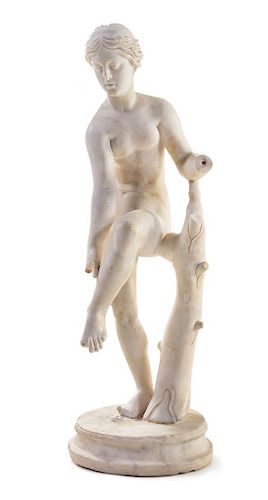* A Roman Marble Venus Height 35 inches.
Lot 26
About Seller
Hindman
1338 West Lake Street
Chicago, IL 60607
United States
Recognized as the Midwest's leading fine art auctioneers, Hindman Auctioneers has built a worldwide reputation based on a full service approach to the auction business tailored to meet the individual needs of our clients. Coming from a variety of educational backgrounds, specialists bring years of e...Read more
Estimate:
$60,000 - $90,000
Absentee vs Live bid
Two ways to bid:
- Leave a max absentee bid and the platform will bid on your behalf up to your maximum bid during the live auction.
- Bid live during the auction and your bids will be submitted real-time to the auctioneer.
Bid Increments
| Price | Bid Increment |
|---|---|
| $0 | $25 |
| $500 | $50 |
| $1,000 | $100 |
| $2,000 | $250 |
| $5,000 | $500 |
| $10,000 | $1,000 |
| $20,000 | $2,500 |
| $50,000 | $5,000 |
| $100,000 | $10,000 |
About Auction
By Hindman
Oct 30, 2018
Set Reminder
2018-10-30 11:00:00
2018-10-30 11:00:00
America/New_York
Bidsquare
Bidsquare : Worldly Pursuits: The Estate of Steve & Peggy Fossett
https://www.bidsquare.com/auctions/hindman-auctions/worldly-pursuits-the-estate-of-steve-peggy-fossett-3506
Hindman Bidsquare@hindmanauctions.com
Hindman Bidsquare@hindmanauctions.com
- Lot Description
* A Roman Marble Venus
circa 2nd century c.e.
exquisitely carved, still atop its original round socle plinth, the goddess depicted nude, balancing on her right leg, supported below her left elbow by a tree trunk at her left side, reaching down with her right arm toward her raised left ankle, her left knee bent, her body leaning forward, creased across her waist and twisting to the left, her sensual form with dimples low on her back, her youthful face with idealized features, her gaze directed down toward her left foot, with thick upper and lower lids, her center-parted wavy hair bound in a fillet and tied at the back in a chignon at the nape of her neck, fine rasp work visible throughout, the surface highly polished along her body.
Height 35 inches.
Estimate $60,000-90,000
Provenance:
Acquired from Robin Symes, London, June 8, 1987
Note:
Venus was the Roman goddess of love, known as Aphrodite to the Greeks. The image of the goddess Venus untying her sandal as she prepares for her bath is an iconic one, known from numerous examples in various media and dimensions. Based on a Hellenistic original from the late 3rd century B.C.E., it was especially favored by the Romans as decoration in the private villas of the wealthy elite.
The sculptural form, especially in marble, was an artistic challenge for the ancient artist. Quite typical of the period, the challenge posed was not only the study of the female body, but the complexity of the weightlessness and balance of the form. The goddess stands precariously in a position of imbalance while concentrating on her strictly private task. The stance accentuates her perfected godly sensuality as well as her humanness, participating in an action so mundane it is replicated by all women every day while undressing. As here, the sandal is often not present on sculptures of the type, perhaps it was painted on, or perhaps it was simply understood by the viewer to be present.
Placed back on the original plinth. A break through the three trunk, possible through the bicep of each arm, through the neck, below the right knee, below the left knee, all with minor fill. The left hand lost from the wrist, the right fingers mostly lost. Most of the right toes lost. The big toe on the left foot lost. The tip of the nose lost. Surface wear, chips, minor abrasions and minor incrustation throughout. Highly polished in antiquity. - Shipping Info
-
Please refer to https://www.lesliehindman.com/shipping-packing/
-
- Buyer's Premium



 EUR
EUR CAD
CAD AUD
AUD GBP
GBP MXN
MXN HKD
HKD CNY
CNY MYR
MYR SEK
SEK SGD
SGD CHF
CHF THB
THB











